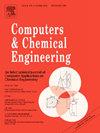利用可行的湿度图和模型预测控制器对 PEM 燃料电池中的水和热进行管理
IF 3.9
2区 工程技术
Q2 COMPUTER SCIENCE, INTERDISCIPLINARY APPLICATIONS
引用次数: 0
摘要
水和热管理对于 PEM 燃料电池 (PEMFC) 的性能、效率和寿命至关重要。要实现有效的水和热管理,就必须设计出能够将水平衡和温度保持在稳定和最佳水平的控制系统。在本文中,我们考虑了集成了水回收和冷却系统的 PEM 燃料电池堆。为了能够预测水含量和温度对燃料电池输入的响应,我们开发了一个机械动态模型。水管理使用一个级联安排的监督模型预测控制器(MPC)以及本地阳极和阴极 PID 湿度控制器来平衡膜含水量。热管理包括一个单独的 MPC 控制器,用于调节燃料堆温度。这项工作的新颖之处在于,在控制膜含水量时,确定并利用阳极和阴极相对湿度的可行区域。我们引入了可行湿度图 (FHP),它定义了给定燃料电池设计及其运行条件下阳极和阴极相对湿度的可行值。这些有用的信息有助于为水管理系统的本地 PID 湿度控制器分配设定值。模拟结果表明,水管理和热管理 MPC 控制器协同工作,成功跟踪了湿度和温度的理想设定值变化,同时拒绝了负载变化等外部干扰。此外,该控制系统对建模错误和燃料电池老化可能导致的模型-设备不匹配具有鲁棒性。本文章由计算机程序翻译,如有差异,请以英文原文为准。
Water and thermal management in PEM fuel cells using feasible humidity plots and model predictive controllers
Water and thermal management are critical for the performance, efficiency and longevity of PEM fuel cells (PEMFCs). Effective water and thermal management require the design of control systems that can maintain the water balance and temperature at stable and optimal levels. In this paper, we consider a stack of PEM fuel cells integrated with a water recovery and cooling system. A mechanistic dynamic model is developed to be able to predict the water content and temperature in response to the fuel cell inputs. Water management uses a cascade arrangement of a supervisory Model Predictive Controller (MPC) and local anode and cathode PID humidity controllers to balance the membrane water content. Thermal management consists of a separate MPC controller to regulate the fuel stack temperature. One novelty of this work lies in identifying and utilizing the feasible region for the relative humidities of the anode and cathode when controlling the membrane water content. We introduce the feasible humidity plots (FHP) which define the feasible values for the anode and cathode relative humidities for a given fuel cell design and its operating conditions. This useful information helps to assign the set-point values to the local PID humidity controllers of the water management system. It is shown by simulations that the water and thermal management MPC controllers work in tandem and successfully track the desired set-point changes in humidity and temperature while rejecting external disturbances such as load changes. In addition, the control system is robust against modeling errors and possible model-plant mismatch introduced by fuel cell aging.
求助全文
通过发布文献求助,成功后即可免费获取论文全文。
去求助
来源期刊

Computers & Chemical Engineering
工程技术-工程:化工
CiteScore
8.70
自引率
14.00%
发文量
374
审稿时长
70 days
期刊介绍:
Computers & Chemical Engineering is primarily a journal of record for new developments in the application of computing and systems technology to chemical engineering problems.
 求助内容:
求助内容: 应助结果提醒方式:
应助结果提醒方式:


